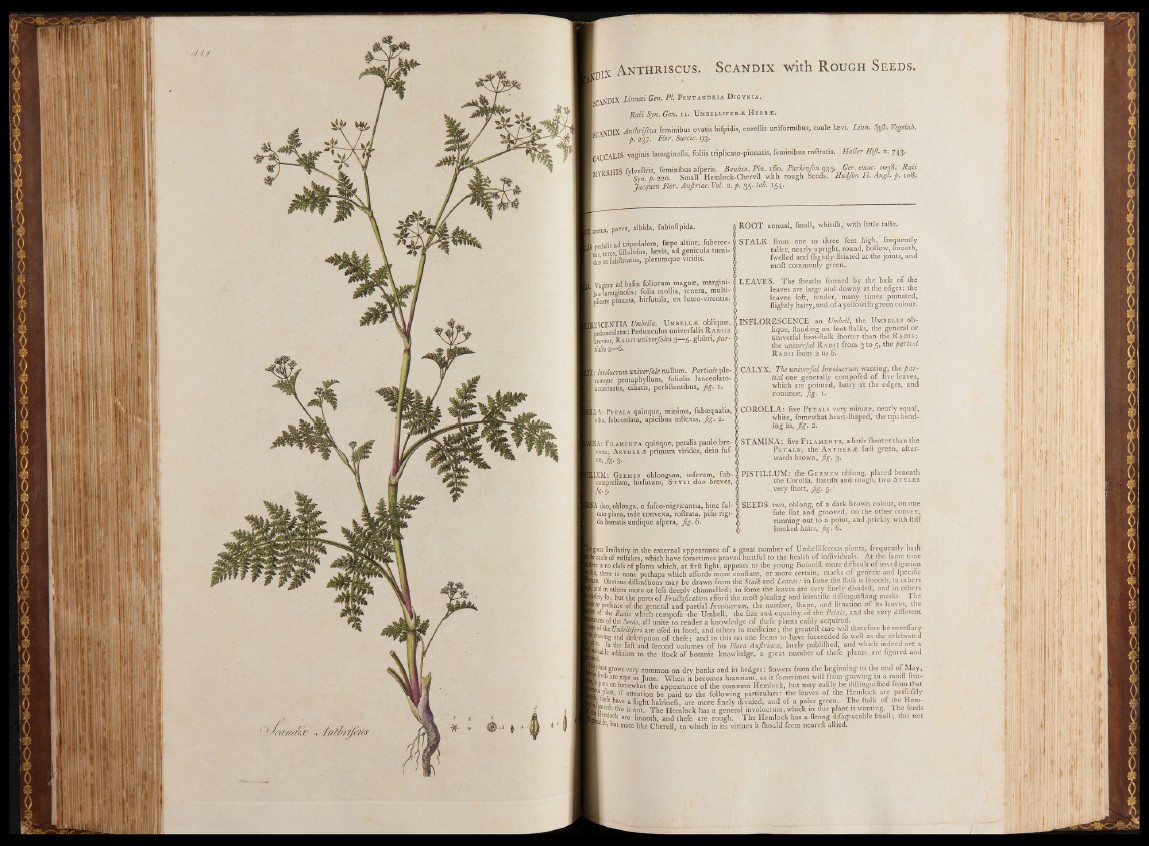
ScANDix with Rough Seeds.
IjCaNDIX Linncd Gen. PI. P e n t a n d r ia D ig y n ia .
Raii Syn. Gen. 1 1 . U m b ell iferas H er b ie .
L amDTX Anthrifcus feminibus ovatis hifpidis, corollis uniformibüs, caule lasvi. Linn. Syfi. Vegetab.
i CA . p. 237. Flor. Suede. 93.
I aUCALIS vaginis lanuginofis, foliis triplicato-pinnatis, feminibus roftratis. Haller Hiß. n. 743.
L v d rHIS fvlveftris, feminibus afperis. Bauhin. Pin. 160. Parkinfon q^ß. Ger. emac. 1038. Ran
iMYKKma 7 ^ p' 22o Small Hemlock-Chervil with rough Seeds. Hudfon Fl. Angl. p. 108.
Jacquin Flor. Außriac.Vol. 2. p. 3$.tab. -154.
■
Tinnua, parva, albida, fubmfipida.
B nedalis ad tripedalem, faepe altior, fuberec-
■ ff,s teres, fiftulofus, laevis, ad genicula tumi-
Pusetfubftriatus, plerumque vindis.
■ Vaginae ad bafin foliorum magnae, margini-
■ bus lanuginofis; folia mollia, tenera, multi-
|plicate pinnata, hirfutula, ex luteo-virentia.
■ RESCENTIA Umbella. Umbell^e obliquae,
Tpedunculatae: Pedunculus univerfalis Ra d iis
Jbrevior, Radii univerfales 3— 5. glabri, par-
■ tides 2—6.
» ROOT annual, fmall, whitifti, with little tafte.
) STA LK from one to three feet high, frequently
' taller, nearly upright, round, hollow, Imooth,
fwelled and {lightly ftriated at the joints, and
mod commonly green.
b LEAVES. The {heaths formed by the bafe of the
* leaves are large and downy at the edges: the
leaves foft, tender, many times pinnated,
fliglitly hairy, and of a yellowifh green colour.
| INFLORESCENCE an Umbell, the U mb e ll s oblique,
{landing on foot-ftalks, the general or
univerfal foot-ftalk {horter than the R a d i i ;
the univerfal R a d i i from 3 to 5, the partial
R a d i i from 2 to 6.
inwbimmmiverfale nullum. Partiale pie- fj CALYX. The univerfal Involucrum wanting, the fiar-
Viumque pentaphyllum. foliolis lanceolato- l Hal one generally compoled of five leaves
lacuminatis, ciliatis, perfiftentibus, Jig. 1. 0 which are pointed, hairy at the edges, and
* *> continue, fig. 1.
»LA: Petala quinqne, minima, fubmqualia, V COROLLA: five Petals very minute, nearly equal,
“ " . fubcordata, apicibus inflexis, Jig. 2. § white, fomewhat heart-lhaped, the tips bend-
* >ng in, Jig. 2.
^ STAMINA: five Filaments, a little {horter than the
Pe t a l s ; the A nthera firft green, afterwards
brown, fig. 3.
UNA: Filamenta quinque, petalis paulo bre-
; Anthers primum virides, dein furie*.
Mr 3 •
HUM: Germen oblongum, inferum, fub-
opreffum, hirfutum, St y l i duo breves,
■
|A duo, oblonga, e fufco-nigricantia, hinc ful-
cato plana, inde convexa, roftrata, pilis rigi-
dis hamatis undique afpera, fig. 6.
(PISTILLUM: the G ermen oblong, placed beneath
the Corolla, flattilh and rough, two Styles
. .very fhort, fig. 5.
r SEEDS two, oblong, of a dark brown colour, on one
fide flat and grooved, on the other convex,
running out to a point, and .prickly with {tiff
hooked hairs, fig, 6.
[great fimilarity in the external appearance of a great number of Umbelliferous plants, frequently hath
icaufe of miflakes, which have fometimes proved hurtful to the health of individuals. At the fame time
p is no clafs of plants which, at firft fight, appears to the young Botanift more difficult o f inveftigation
p, there is none perhaps which affords more conftant, or more certain, marks of generic and fpecific
le. Obvious diftinflions may be drawn from the Stalk and Leaves: in fome the ftalk is fmooth, in others
jn d in others more or lefs deeply channelled; in fome the leaves are very finely divided, and in others
■ rfely fojjbut the parts of Fructification afford the moft pleafing and fcientific diftinguifhing marks. The
^or prefence of the general and partial Involucrum, the number, fhape, and fit nation of its leaves, the
■ of the Radii which compofe -the Umbell, the fize and equality of the Petals, and the very different
jfces of the Seeds, all unite to render a knowledge of thefe plants eafily acquired.
(ofthe Umbelliferi are ufed in food, and others in medicine; the greateft care will therefore be neceffary
hawing and defeription of thefe; and in this no one feems to have fucceeded fo well as the celebrated
If* In the firft and fecond volumes of his Flora Aufiriaca, lately publifhed, and which indeed are a
^ “able addition to the {lock of botanic knowledge, a great number of thefe plants are figured and
IH g row s very common on dry banks and in hedges: flowers from the beginning to the end of May,
T r ds are ripe in June. When it becomes luxuriant, as it fometimes will from growing in a moift fitu-
Bpnts on fomewhat the appearance of the common Hemlock, but may eafily be diftinguifhed from that
f c l i F r ’ I attention be paid to the following particulars: the leaves of the Hemlock are perfeftly
thefe have a flight hairinefs, are more finely divided, and of a paler green. The ftalk of the Hem-
SfpH e?5 €P is not. The Hemlock has a general involucrum, which in this plant is wanting. The feeds
•IS u are fmo°tb, and thefe are rough. The Hemlock has a ftrong difagreeable fmell; this not
f Dle> “Ut more like Chervil, to which in its virtues it ffiould feera neareft allied.